Pistols Firing Internally Silenced Ammunition
Guns of the Spetsnaz Pt III
As discussed in previous articles on the subject, Soviet Spetsnaz troops played a key role in Soviet military doctrine, in both local operations (mostly in third world countries such as Afghanistan) and in possible global war in Europe. In either case, Spetsnaz required, among other things, weapons that could be used with at least some degree of stealth. The silenced 9×18 PB pistol, as well as 9×18 APB machine pistol, filled the bill for military-type silenced pistols, but only to the certain extent.
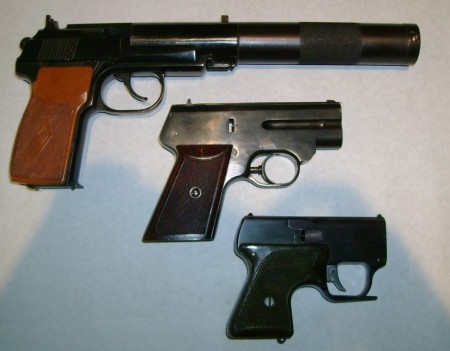
What was more important to our story is that there was another customer to highly specialized small arms within Soviet ‘power’ system – the almighty Committee of the State Security, or the KGB in short. Among other things KGB was deeply engaged in secret espionage and counterespionage operations across the world, with many undercover agents looking for western secrets while trying to keep Soviet secrets from Western rivals. This game, obviously, was quite dangerous, and undercover agents sometimes were required to protect themselves with lethal force while maintaining maximum stealth. Another part of the game was political murders and termination of defectors, which also required highly specialized weapons for stealth execution.
The father of the current breed of such weapons in Soviet service was the already mentioned Igor Stechkin, author of the famous APS machine pistol. During mid-fifties he was requested by KGB to create a deep-concealment weapon, disguised as something that looks completely safe, and firing poison-tipped bullets without any noise or flash. To achieve the latter effect, Stechkin employed rather old principle of capturing hot powder gases (prime source of the sound and flash during the discharge) within confined space. First attempts to produce weapons using this idea in USSR can be tracked to just prior to WW2, when Soviet designer Gurevich converted Nagant revolver to fire saboted .22 caliber bullets. Each bullet was loaded into standard 7.62mm Nagant cases using 7.62mm sabots. The muzzle of the revolver was fitted with second cylinder with tapered bore (7.62mm at the rear, 5.6mm at the front), so, when gun was fired, bullet was able to pass through the front cylinder, while following sabot was jammed in the tapered bore and captured most of the powder gases inside the barrel. After a short while both cylinders (mounted on the same extended axis pin) could be rotated for next shot. After shooting, captured sabots were to be pushed out of the front cylinder manually. Of cause, such system was extremely bulky and complicated. It also must be noted that simpler versions of the same concept were known (or at least patented) well before Gurevich – author was able to find an US patent No 692,819, dated back to 1902 and titled “Means for effecting noiseless discharge of guns”, which describes a cartridge that contains an internal piston to capture powder gases within the cartridge case, once the piston has moved all the way to the front of the long case, pushing the bullet out with some energy.
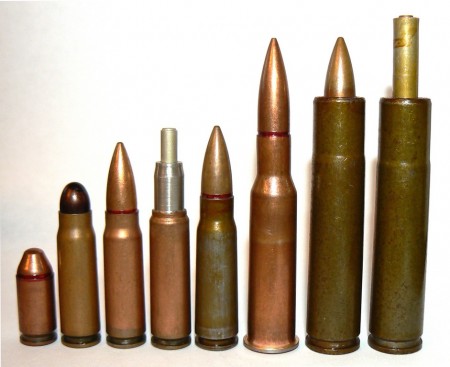
The first noiseless cartridge developed by Stechkin was designated SP-1 (Spetsialnyj Patron 1 – Special Cartridge model 1). It was based on 9×18 case, loaded with special bi-caliber bullet and small piston, which was located between bullet base and powder charge. The bullet had front part of 7.62mm caliber, with base being of 9mm caliber, and it was intended to be fired through the squeeze-bored barrel with decreased caliber muzzle. That way, bullet base was squeezed to the 7.62mm and then free to exit the bore, while the piston was jammed in the bore, capturing powder gases inside the barrel. Of cause, this system was to be used only in manually loaded single-shot weapons, and one such weapon (declassified recently) was made to imitate a tin cigarette case, with three 9 / 7.62mm barrels and firing mechanism fitted inside.
The SP-1 cartridge never went past prototype stage, but within several years Stechkin designed his next internally silenced cartridge, known as SP-2. This one also contained a small powder charge behind the piston, but this time powder gases were to be captured inside the bottlenecked cartridge case, which looked somewhat similar to that of the 7.62×39 M43 round. Since the pusher piston was relatively short, and before discharge seated deep in the cartridge case, the bullet had to be made long, but relatively light. To achieve this, Stechkin used metal jacket taken from an unassembled 7.62mm pistol (7.62×25) bullet and fitted it with aluminum core that extended back from the jacket to rest on the piston.
This round apparently was produced in very limited numbers and used in some ‘Q-style’ weapons, such as the three-shot pistol disguised as a tin cigarette container. Also, it was probably used in the earliest model of the more convenient-looking two-barrel derringer-type pistol, which served as a predecessor to the MSP pistol described below.
The following part of the history is very dim at its best, but what is known is that in around 1965 the KGB, as well as its most important rival within the Soviet intelligence system, the GRU (Intelligence Department of the General Staff, Soviet Army), both adopted the “noiseless pistol complex”, which consisted of the integrally silenced 7.62mm cartridge, known as PZ (Patron “Zmeya” – “Snake” cartridge) and the 2-barreled, derringer-type pistol known as S4. The PZ ammunition, which was the heart of the system, consisted of the machined steel case 63mm long, with screw-in base. It featured a tapered inner bore, with single stage pusher piston inserted from the rear. A small amount of special propellant was loaded behind the piston, and the base was securely screwed in to form an air-tight, variable volume container for powder gases. The cartridge base itself was a complicated subassembly, as it contained a standard primer, a small firing pin behind it, and a screw-in bushing to keep the primer and pin in the base under the pressure of powder gases. The projectile was inserted from the front. It was a standard 7.62mm pointed bullet as used in 7.62×39 M43 ammunition, with possible intent to fool the investigators and make them seek for a sniper that fired an AK or SKS rifle from a stand-off distance, rather than to look for a secret agent that shot the target from almost point-blank range.
Over the time, the PZ cartridge evolved through several minor variations in the shape, design of the base plug and primer retaining arrangement, with definitive version known as PZAM. It is believed that this weapon complex saw at least some use in the hands of the GRU Spetsnaz during Soviet incursion into Afghanistan, and, in modified form (S4M pistol and PZAM ammunition) it is still can be found in the armories of the certain highly specialized units within Russian Military and Internal Affair ministry.
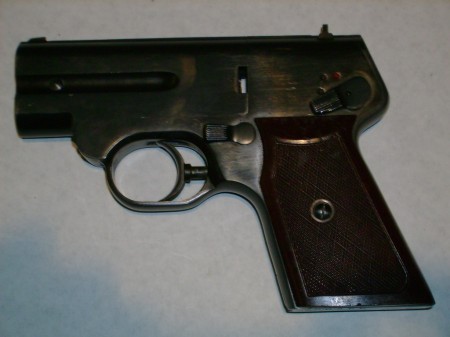
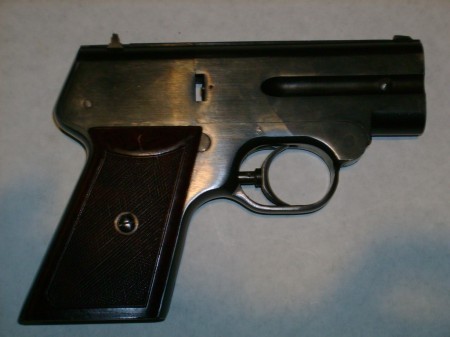
Being more or less effective, the S4M apparently still left something to be desired, especially from the point of view of the plain-clothes agents of both KGB and GRU. Both pistol and ammunition were too heavy and bulky for intended use, and during late sixties Igor Stechkin returned for his drawing board with intent to design a more compact weapon of comparable performance. He started with ammunition. The limiting factors in size and weight of the internally silenced ammunition are the strength of the case (which has to withstand high pressures without bursting even when removed from the chamber) and the length of the piston, which takes space between the bullet and the powder load.
The case strength issue was apparently solved with use of special propellant of somewhat reduced power and by allowing the case to be fire-formed at the neck by the moving piston when fired, and the piston length was decreased with adoption of the two-part telescoped piston. Of cause, the two-part piston is more complicated and thus expensive to make, but during the Soviet times KGB budgets were never short for new toys, and, in fact, it is possible that overall new cartridge was still less expensive than PZ series due to the use of a single-piece drawn steel case with conventional primer (crimped in the base) instead of the multi-part machined steel case of the PZ series. The load for the new round was the same M43 bullet, weighing 7.9 gram (122 grains), but the muzzle velocity dropped to about 145 m/s (475 fps), resulting in muzzle energy of only 83 Joules (61 Ft-Lbs) – about half that of .32 Auto / 7.65 Browning ammunition. This performance may look quite marginal at its best, but one must remember that this ammunition used relatively heavy pointed bullets, which provided better penetration than lighter, blunt-nosed pistol bullets, and, not less important, that this gun was to be used by highly trained personnel which knew where to put each bullet for maximum effect.
With new ammunition on hand (index SP-3, metric designation 7.62×37), Stechkin and his team at Tula arms factory then developed another derringer-type, break-open pistol with two barrels, which was adopted by KGB and Soviet military in 1972 as MSP (Malogabaritnyj Spetsialnyj Pistolet – small special pistol), and it is still remains in limited service with elite units in Russian law enforcement (mostly in anti-terrorism units).
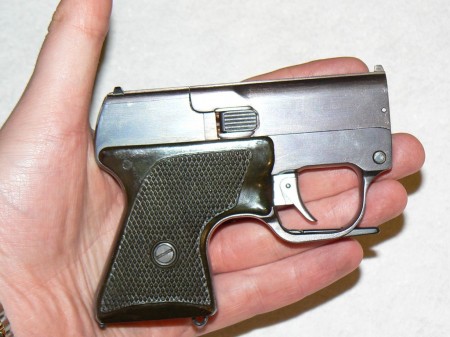
Shooting the guns
The author was only able to fire MSP, as the military facility (which had both MSP and S4M in its reference collection) was out of PZAM ammunition at the time. Loading the clip with two rounds was a relatively simple operation. The pistol was then loaded with clip, and cocked using the lever.
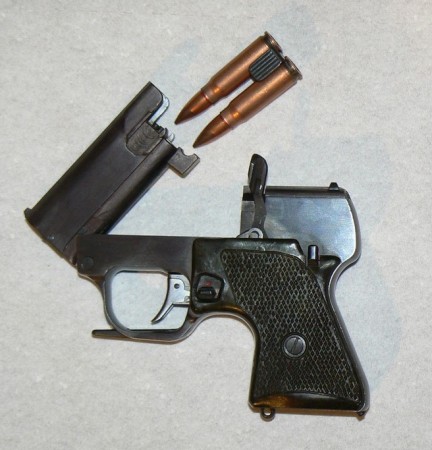
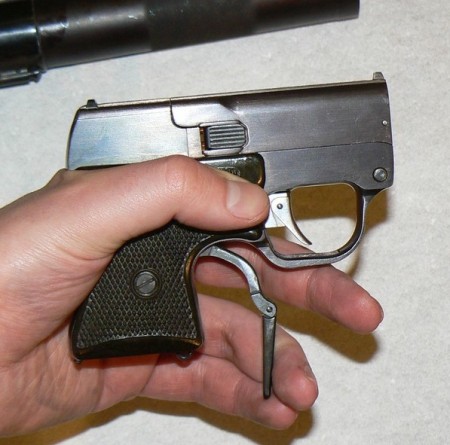
Firing was commenced from 15-meters range, off-hand. The noise of the firing was almost unrecognizable even in the indoors range and without earmuffs, and the loudest sound came from steel backstop behind the target which was struck by the bullets. It is easy to imagine that, if being fired in the streets even in the quiet time, the shots will not be noticed unless someone will directly spot either the gun or the fallen target. The accuracy was rather acceptable – both bullets struck about an inch one from another (spaced vertically) very close to point of aim (about 2 inches below POI, in fact, but I personally would attribute that to the inaccuracy of the shooter rather than the gun). Penetration was not tested, but it seems that it was considered adequate for its intended purpose by those who used this gun in the line of duty.
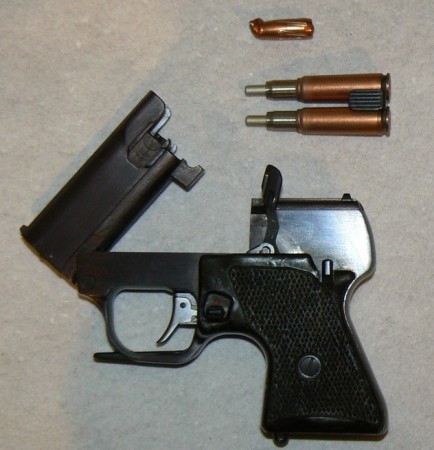
S4M Noiseless Pistol
The S4M is a two-barreled pistol with tip-up barrels. Cartridges are loaded and unloaded in pairs, using a specially designed steel clip. The pistol has neither ejector nor extractor, as the clip is removed manually during reloading. The trigger is single action, concealed hammers being cocked manually by pulling down a special lever, located at the base of the grip. A manual safety is located at the left side of the frame, above the grip and, quite unusually, has three positions – topmost is for safe, middle is to fire only one (bottom) barrel, and bottom position allows firing both barrels consecutively by pulling the trigger twice. One might only speculate the reasons for this arrangement. Sights were fixed, with drift-adjustable rear blade. The barrel lock lever was located on the left side of the frame, behind and slightly above the trigger.
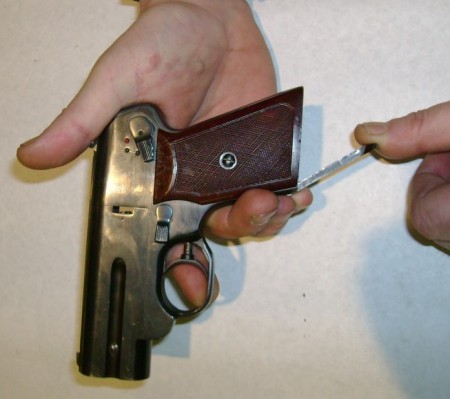
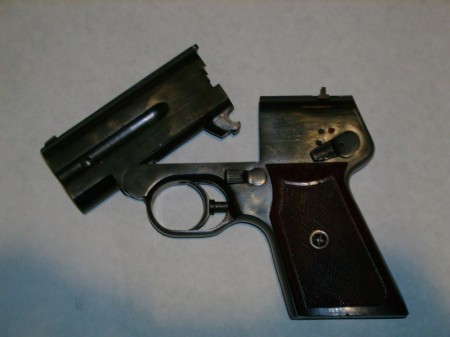
Not surprisingly, the gun is devoid from any manufacturer or model markings or proofs. Ammunition is also devoid from any headstamps and markings.
Technical Specs (S4M)
Trigger type: Single action
Caliber: 7.62x63mm PZAM
Muzzle velocity: 557fps (170m/s)
Weight, empty: 21.2oz (600g)
Overall length: 5.8″ (147mm)
Barrel length: N/A (cartridge case acts as barrel)
Ammunition capacity: 2-round clip
MSP noiseless pistol
The MSP is a two-barreled pistol with tip-up barrels. Cartridges are loaded and unloaded in pairs, using a specially designed steel clip. The pistol has special extractor which retracts the clip with spend cases partially from the gun, and then the clip is removed manually. The trigger is single action, concealed hammers being cocked manually by pulling down and to the rear a special two-piece lever, located at the base of the trigger guard. A manual safety is located at the left side of the frame, just behind the trigger. Sights were fixed, with drift-adjustable rear blade. The barrel lock lever was located on the left side of the frame, behind the breech area of the barrel cluster, and must be pushed up for unlocking.
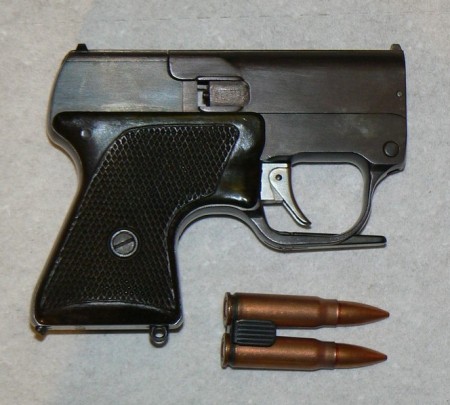
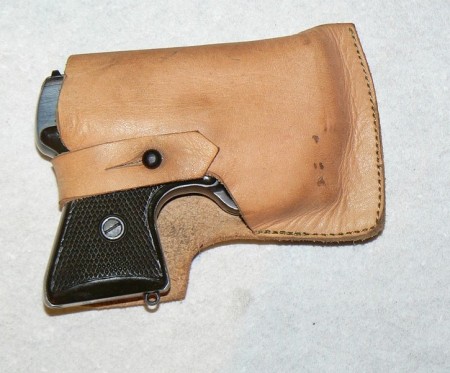
Like its predecessor, the MSP is devoid from any manufacturer or model markings or proofs. Ammunition is also devoid from any headstamps and markings.
Technical Specs (MSP)
Trigger type: Single action
Caliber: 7.62x37mm SP-3
Muzzle velocity: 475fps (145m/s)
Weight, empty: 18.7oz (530g)
Overall length: 4″ (101mm)
Barrel length: N/A (cartridge case acts as barrel)
Ammunition capacity: 2-round clip
Want to see more of Max’s work? He has several print books written in cooperation with noted ammunition expert Anthony Williams available for sale, including:
Assault Rifle: The Development of the Modern Military Rifle and its Ammunition
Machine Gun: The Development of the Machine Gun from the Nineteenth Century to the Present Day
Modern Combat Pistols: The Development of Semi-automatic Pistols for Military and Police Service Since 1945
and
Sub-Machine Gun: The Development of Sub-Machine Guns and their Ammunition from World War 1 to the Present Day (we also have a video review of this one)

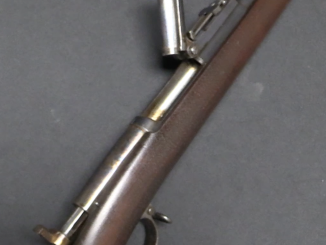


It is to the designer’s credit that an effective, functional sub-compact pistol of this type was manufactured and put into service while still being able to accommodate the relatively large cartridges used. At the close ranges involved for its intended purpose and with proper shot placement, the pistol would have been quite effective, more so than the figures for muzzle velocity and muzzle energy would imply.
Max — thanks for the great write-up. Very interesting and certainly intriguing, to say the least. By the way, I think that you are too modest when it comes to your abilities during test-firing, but then again someone who is truly established as a real professional is always a realist and has no need for self-promotion. That is one compelling reason why I prefer FW first and foremost for discussions and learning — good people, open minds, shared experiences, great guns and an excellent webmaster / moderator:).
Thank you Mr. Max Popenker and Ian for the collaboration on this great, informative article.
I’m no expert, but it is my understanding that at least one, and possibly several of the MSP silent pistols were recovered by the Salvadoran armed forces from FMLN rebels during the November 1989 offensive, which led ultimately to the 1992 cease-fire and political accords. The Farabundo Martí guerrillas were apparently quite sophisticated in terms of logistics, so I do not know if these specialized pistols came from the Soviet Union, the Socialist Bloc, or, quite possibly, from Cuba. Early on in the Salvadoran civil war some crudely sanitized Cuban FALs turned up, and other arms may have been trans-shipped from Cuba.
Great article on a really interesting subject.
I seem to remember that someone in the U.S. developed a ‘silent’ 12 gauge shotgun cartridge which used a deep drawn steel cup which was reversed back into itself to act as a piston. It suffered from the same low velocity as these Russian SP cartridges, but would have been less expensive to produce en masse. Anyone remember this cartridge?
John D: “U.S. Navy Silent Shotgun Shell” … developed by AAI Corp in 1967 during the Vietnam War. See Thomas F. Swearengen, _The World’s Fighting Shotguns_ (Alexandria, VA: T.B.N. Enterprises, 1978), 480-484.
Robert Schnepfe was the designer, although the “Telecartridge” was designed by I.R. Barr. Supposedly by early 1968 200 “Silent Shotgun Shells” were delivered to the U.S. Naval Ordnance Laborator. Illustrated is a prototype shell with No.4 buckshot. 12 .24″ No.4 buckshot weighing 20grains each. 450 feet per second.
This is not first time I read on the subject, however this time the material (thanks to Mr.Popenker) is exceptionally well presented.
One thing is on back of my mind and I like to get it to open: with all these ‘revelations’, does it mean that Motherland gave out its secrets? This kind of hardware is still very valuable and is/ may be to good use anytime in future.
Oh, I imagine they have an even more advanced system in place today, probably a magazine fed manual repeater or revolver (to prevent the mechanical noises of an automatic) using an even more compact cartridge arrangement. While some of these may still be in inventory, the designs are rather old at this point. After all, the U.S.Army still has unissued M3A1’s in inventory, even though for the most part they are long obsolete.
there are at least two more generations of internally silenced weapons that are openly displayed and published in the Russian press (i.e. PSS self-loading pistol, OTs-38 revolver and forthcoming PSS-2 pistol)
I believe a lot more is still classified.
Ian, as always, nice post. In answer to a question/statement above, yes, the newer silent ammo is much better. One example of how is the the piston doesn’t protrude past the shell casing so is easily used in semi-guns like the PSS. The U.S.’s version from the 1960’s is fun to read about as it is shot out of a modified Smith & Wesson (yes, I’m a revolver fan). Called it “Tunnel Weapon” for use by tunnel rats back then. It had shot shell and solid projectile ammo(If Ian wishes I’ll email him all the manuals I have on it). The tech of this field truly has gotten better since the 60’s, Russian and US.
I figure this may have been directed to me and I appreciate. Regarding your ‘tunnel-rat’ thing, were those to flush VC out of their tunnels? This required quit a bit of balls, as I imagine. Why revolver was better for it?
Growing up knew a 101st Airborne Capt who stood all of about 5 feet tall. In Vietnam people told him that if he hadn’t been an officer he would have made a great tunnel rat. He said that entailed going into a tunnel with a flash light and a 1911. He said that if one fired more than five (or may have been six?) rounds in one tunnel that they were disciplined in some way. It was apparently seen as a very bad thing to run dry in a tunnel. I got the impression they didn’t do New York reloads or carry extra magazines, and the tunnel rats went in solo. Suspect that those tactics were used so as not to be rushed if the VC were hiding in the dark counting shots.
Not sure how a revolver would be better, unless it was better reliability than 1911’s that hadn’t been made since WWII. A grease gun would seem to have been the ideal weapon in theory. In WWII Pacific flame throwers and bulldozers were used for this sort of thing, but that was mainly against shallow caves, not tunnels.
Anyone out there with first hand knowledge of tunnel rats?
Tunnel rats silent handgun should be preferred
as revolver, most probably by cause of their
rather noiseless and ensured manually acting
cycling features with a long cased ammunition
having risks to operate an autoloading mechanism.
From the quick search I did using the links in this comment thread, I note that the S&W revolvers used a .44 casing with a flange around the casemouth, permitting a .40 projectile to pass through while trapping the .44 piston. The barrel was replaced with a very short .40 smoothbore barrel. An advantage of a revolver in this situation is that there’s a gap between the casemouth and barrel, and if this piston’s impact deforms that flange, it simply bends into that gap. God knows what messy things would happen in an automatic with a chamber that steps down in size at the casemouth.
before tunnel rats went in the tunnels.. they sent in several hungry rats to flush out the enemy. I saw this film by the marines doing this..as soon as the enemy ran out with several rats latched to their skin…waiting marines would shoot them dead, then go in to blow up the tunnels.
@ jacob Morgan And Denny — RE : Tunnel Rats
For a real in-depth look at the Tunnel Rats and their erstwhile adversaries in the almost-forgotten underground battles of the Vietnam War, read “The Tunnels Of Cu Chi — A Harrowing Account Of America’s Tunnel Rats” In The Underground Battlefields Of Vietnam” by Tom Mangold and John Penycate. It is a very good book that presents the conflict as witnessed by participants from both sides and details the tactics and techniques used. The book has been published in various editions over the years and the current paperback version is from Mass Market Paperbacks. Used copies are available from $3.32 up and new ones from $3.65 up on Amazon.com.
There is a lot of first-hand technical and historical information that you will be able to absorb at your leisure, far more than what I, or anyone else, could write about in this blog.
Sorry about the typo, I meant ” @ Jacob Morgan And Denny”.
Another interesting account of underground warfare as seen from the Australian perspective is “Tunnel Rats” by Sandy MacGregor and Jimmy Thomson. It chronicles the exploits of 3 Field Troop, Army Engineers during Australia’s involvement in Vietnam, and Amazon.com has it from $15.45 up.
Yeah Earl, as much as I try to keep on topic, it is so easy to digress. That “rat” thing got me going…. I should try to get the book.
Same time we all know (and I am sure that includes moderator as well) that weapon’s technology is inextricably connected with tactics; as a matter of fact guns are mostly designed with view of tactics as a primary objective – case in point being ‘silent guns’.
I absolutely agree! Let me know what you think after you’ve read the book.
Excellent!
Can we expect more about the PSS and Devices D and DM?
Of interest:
IAA article about the history of the concept: http://www.scribd.com/doc/75349633/Pressure-Sustaining-Cartridges
Report about US development of such ammunition in the sixties: http://www.dtic.mil/cgi-bin/GetTRDoc?AD=AD0334799
SADJ have some details about the PSS with actual dB and performance tests:
http://sadefensejournal.com/wp/?p=307
http://sadefensejournal.com/wp/?p=1812
PSS – sure yes
for devices D and DM I need better photos that I have on hand
We know you’ve had access to the ammunition 🙂
http://iaaforum.org/forum3/viewtopic.php?f=8&t=8633&view=next
it’s only fired shells. I’m still looking for complete (dummy) rounds of PFAM, or at least fired projectiles
rare as hen’s teeth 🙁
Vietnam War tunnel rats.
Duncan Long, _Streetsweepers: The Complete Book of Combat Shotguns_ (Boulder: Paladin Press, 2004), p.56.
“Quiet, Special Purpose Revolver… fielded in Vietnam in 1969 for use by tunnel rats … modifying a Smith & Wesson Model 29 magnum revolver, shortening its barrel so that it was slightly more than 1 inch long… silent-shot ammunition…
Overall length: 6.75-inches
Barrel length: 1.37 inches
Weight: 2.01 pounds
Capacity 6 rounds.
Tom Mangold & John Penycate, _The Tunnels of Cu Chi_ (NY: Berkeley Books, 1985), pp. 98-107:
The knife or bayonet was the preferred weapon.
Some “tunnel rats” used silencers, most did not. .38 S&Ws, either purchased from helicopter or aircrew appeared to be preferred by many. “a ‘balanced, compact, six-shot … modified Smith & Wesson .44 magnum revoler, weighing 38-ounces.’ It fired a special 15-pellet bullet with a shot pattern similar to that of a shotgun, but with smoke and flash virtually eliminated. Called the Tunnel Weapon. …. ” Later, a four-segment bullet was also apparently developed according to one of the authors’ informants.
Looks like the soviets invented the double tap before heizer defense
Back about 15 years ago I built some silent rounds and no I don’t live in the US. I used 39mm long 8mm ext. 6mm int. copper pipe.A crimped shotgun primer served as the propelling charge.The piston was 5mm of 6mm solid alu. rod and I crimped 5mm long 6mm ext. 4mm int. steel tube into the other end. The projectile was a 2.5mm nail with a 4mm tube crimped around it
I had a false 20 gauge shell made up with about 50mms of barrel. no noise but only about 90mms a second based on the dint in a campbell bean can compared to an airrifle at 120ms a second.
“A private individual has producedsilent ammunition for the 12-gaugeshotgun using a simplified version of the Alpha 3 – AAIcaptive pistondesign
The cartridge shows how ingenuity can overcome the technical problems involved and the level of ballistic performance possible from pressure-sustaining ammunition.A metal cartridge case contained a piston in the form of a simple disk of Nylon a ¼” thick. The piston was alsothe gas seal as it interacted with a ‘lip’at the case mouth to retain the propellant gases inside the case.The projectile was a steel dart; body diameter of 0.310” with four bore size plastic fins and weighing 240 grains. Reported velocity was 585 fps using a charge of 6.0 grains of Hercules Bullseye propellant”
Alan Clendinen – The Silent Shotgun Shell, Firepower, November 1987
I’m a bit confused… What happens to the cases after they are fired and left on the ground? Are the expanded gases just kept inside the cases forever? Don’t they reach a point of fatigue over time when they simply explode?
I can imagine handling those fired cases can be a bit hazardous… Can somebody please explain this to me?
have a look at this article: http://www.sadefensejournal.com/wp/?p=1812
“It is known that these expended cartridges may contain pressure for several weeks, and attempts to disassemble them within a month of firing can be hazardous”